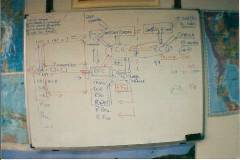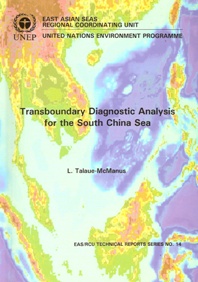
THE UNEP/GEF SOUTH CHINA SEA PROJECT The UNEP/GEF Project Entitled “Reversing Environmental Degradation Trends in the South China Sea and Gulf of Thailand" is funded by the Global Environment Facility (GEF) and implemented by the United Nations Environment Programme (UNEP) in partnership with seven riparian states bordering the South China Sea (Cambodia, China, Indonesia, Malaysia, Philippines, Thailand, and Vietnam). Planning commenced in 1996 and the project became fully operational in February 2002. A brief history of the development of the project can be found at the bottom of this page. Click here to access the Project Document for the UNEP/GEF South China Sea Project. Goals
 The overall goals of this project are: The overall goals of this project are: - to create an environment at the regional level, in which collaboration and partnership in addressing environmental problems of the South China Sea, between all stakeholders, and at all levels is fostered and encouraged; and
- to enhance the capacity of the participating governments to integrate environmental considerations into national development planning.
Medium Term Objective
The medium term objective of the project is to elaborate and agree at an intergovernmental level, the Strategic Action Programme encompassing specific targeted and costed actions for the longer-term, to address the priority issues and concerns.
Project Components
The Project is complex since it addresses three priority areas of concern identified in the Transboundary Diagnostic Analysis (TDA), including:
1. The Loss and Degradation of Coastal Habitats,
2. Over-Exploitation of Fisheries in the Gulf of Thailand, and
3. Land-Based Pollution.
Of these three substantive project components the first, relating to habitat degradation and loss is the largest, being divided into four sub-components (coral reefs, seagrass, mangroves, and wetlands). The fourth component of the project is that concerned with regional co-ordination including facilitation of national level execution and securing inter-country agreement on project related matters.
Outcomes
Major outcomes will include: - An approved Strategic Action Programme including, a targeted and costed programme of action and a recommended framework for improved regional co-operation in the management of the environment of the South China Sea,
- A series of national and regional management plans for specific habitats and issues;
- A suite of demonstration management activities at sites of regional and global significance; and
- A framework regional system of fisheries refugia in the South China Sea and Gulf of Thailand; and
- Pilot activities relating to alternative remedial actions to address priority transboundary pollutants and adopted water quality objectives and standards.
Stakeholder Involvement The project was designed to be implemented over a period of five years and involved the signing of Memoranda of Understanding (MoUs) between UNEP as the GEF Implementing Agency and seven focal Ministries, (the Ministries responsible for Environment in each country) and thirty-one Specialised Executing Agencies (SEAs) in the seven participating countries, each responsible for one component or sub-component. These institutions and organizations comprise fourteen government departments, eleven research institutions, five universities and one Non-Governmental Organisation (NGO).
 The extent of stakeholder involvement to date is only partially reflected by these MoUs concluded between UNEP and the Specialized Executing Agencies. A number of the SEAs have also established institutional sub-contractual links with other organizations at the national level, such that the network of institutions directly involved to the project has expanded to in excess of one hundred, whereas the number of institutions indirectly involved through individual participation on National Committees and Sub-committees and Regional Working Groups exceeds four hundred. These kinds of linkage facilitate wider stakeholder involvement of local and national NGOs and provincial and local government agencies in the project, which is anticipated to grow as the demonstration sites become fully operational. The extent of stakeholder involvement to date is only partially reflected by these MoUs concluded between UNEP and the Specialized Executing Agencies. A number of the SEAs have also established institutional sub-contractual links with other organizations at the national level, such that the network of institutions directly involved to the project has expanded to in excess of one hundred, whereas the number of institutions indirectly involved through individual participation on National Committees and Sub-committees and Regional Working Groups exceeds four hundred. These kinds of linkage facilitate wider stakeholder involvement of local and national NGOs and provincial and local government agencies in the project, which is anticipated to grow as the demonstration sites become fully operational.
Project Management
A comprehensive review of the management of the South China Sea Project has been prepared by the Project Director, Dr. John C. Pernetta. Follow the link below to access this review.
UNEP, 2005. Managing Multi-Lateral, Intergovernmental Projects and Programmes, the case of the UNEP/GEF Project Entitled: “Reversing Environmental Degradation Trends in the South China Sea and Gulf of Thailand”. [Dr. John C. Pernetta] Project Evaluation The mid-term evaluation of the South China Sea Project was conducted in 2004. The final evaluation report can be accessed by clicking here. HISTORY OF PROJECT DEVELOPMENT During 1996, the Co-ordinating Body for the Seas of East Asia (COBSEA) requested assistance from the United Nations Environment Programme (UNEP) to prepare a proposal for grant assistance from the Global Environment Facility (GEF) in addressing the water related environmental problems of the marine environment in the region. The GEF provided a project development facility grant of 325,000 US dollars to undertake an analysis of the water-related issues and problems of the South China Sea and to design an appropriate multi-country intervention to address the agreed priority issues.
 During the project preparation phase (1997-1998) each of the seven participating countries nominated a national focal point from within the ministries responsible for the environment. The focal points were charged with responsibility for co-ordinating the work of other individuals and institutions in the preparation of a national review of priority, water-related environmental issues and problems. Three expert meetings involving the national focal points and invited experts from the region were convened during this period to review the draft national reports, and determine priority areas of intervention. The seven national reports were published in 1999 and formed the basis for the compilation of a Transboundary Diagnostic Analysis (TDA), and a draft Strategic Action Programme (SAP). Follow the links below to access all related documents: During the project preparation phase (1997-1998) each of the seven participating countries nominated a national focal point from within the ministries responsible for the environment. The focal points were charged with responsibility for co-ordinating the work of other individuals and institutions in the preparation of a national review of priority, water-related environmental issues and problems. Three expert meetings involving the national focal points and invited experts from the region were convened during this period to review the draft national reports, and determine priority areas of intervention. The seven national reports were published in 1999 and formed the basis for the compilation of a Transboundary Diagnostic Analysis (TDA), and a draft Strategic Action Programme (SAP). Follow the links below to access all related documents:
The Transboundary Diagnostic Analysis included a prioritisation of the identified issues and problems prepared on the basis of a Delphi-type exercise conducted during the second expert meeting. The Strategic Action Programme outlined the priority actions required over the subsequent five-year period, to address the issues and problems identified and quantified in the TDA. The Country Reports, the Transboundary Diagnostic Analysis and the draft Strategic Action Programme were presented to the thirteenth meeting of COBSEA (UNEP, 1998c), which took note of the Country Reports and TDA and analysed and approved in detail the draft Strategic Action Programme. On the basis of this draft SAP, the project brief was prepared for consideration by, the GEF Council meeting in March 1999. Not all countries had endorsed the proposal by that time however, and the problems were reported to the fourteenth meeting of COBSEA in November 1999.  There followed an extensive period of negotiation between UNEP and the participating countries during which changes to the document were made to accommodate the concerns of some participating countries. A revised version of the project brief was presented to, and endorsed by the fifteenth meeting of COBSEA in September 2000, which was preceded by an expert meeting of national co-ordinators. This project brief took account of the desire of participating countries to retain full control over the management and execution of the project without involvement of outside parties. The document was included in the GEF Work Programme presented to, and endorsed by the GEF Council in December 2000 for grant support. There followed an extensive period of negotiation between UNEP and the participating countries during which changes to the document were made to accommodate the concerns of some participating countries. A revised version of the project brief was presented to, and endorsed by the fifteenth meeting of COBSEA in September 2000, which was preceded by an expert meeting of national co-ordinators. This project brief took account of the desire of participating countries to retain full control over the management and execution of the project without involvement of outside parties. The document was included in the GEF Work Programme presented to, and endorsed by the GEF Council in December 2000 for grant support.
The project brief contained only a brief outline of the proposed management framework and did not contain details of the instruments that would be used to transfer funds to the national executing agencies. An elaborated management framework and Memoranda of Understanding, together with the terms of reference for, and details of, the proposed membership of the national and regional bodies listed in the management framework were prepared in consultation with the focal ministries in each country during 2001. They were annexed to the operational project document submitted to the GEF Secretariat for final CEO endorsement in December 2001. Prior to this submission the full project document was presented to, and approved by the first meeting of the Project Steering Committee in October 2001 and approved by the sixteenth meeting of COBSEA. The project became operational at the time of final signature of the project document by, UNEP on January 21st 2002. |